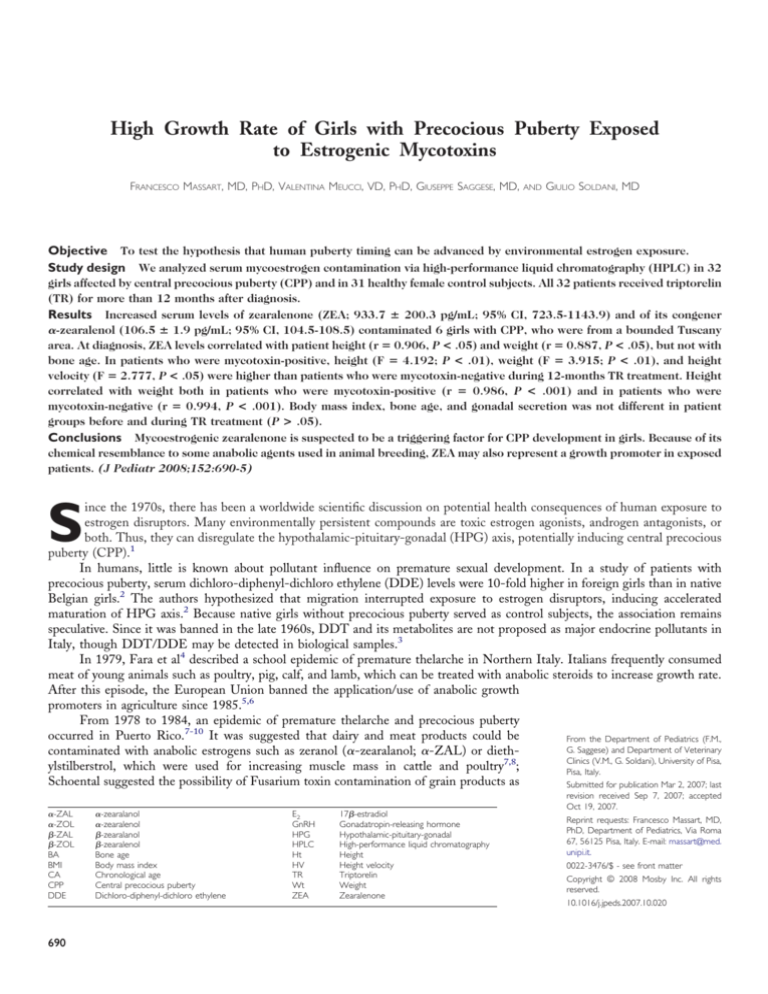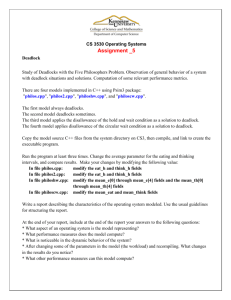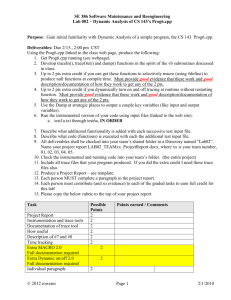
High Growth Rate of Girls with Precocious Puberty Exposed
to Estrogenic Mycotoxins
FRANCESCO MASSART, MD, PHD, VALENTINA MEUCCI, VD, PHD, GIUSEPPE SAGGESE, MD,
AND
GIULIO SOLDANI, MD
Objective To test the hypothesis that human puberty timing can be advanced by environmental estrogen exposure.
Study design We analyzed serum mycoestrogen contamination via high-performance liquid chromatography (HPLC) in 32
girls affected by central precocious puberty (CPP) and in 31 healthy female control subjects. All 32 patients received triptorelin
(TR) for more than 12 months after diagnosis.
Results Increased serum levels of zearalenone (ZEA; 933.7 ⴞ 200.3 pg/mL; 95% CI, 723.5-1143.9) and of its congener
␣-zearalenol (106.5 ⴞ 1.9 pg/mL; 95% CI, 104.5-108.5) contaminated 6 girls with CPP, who were from a bounded Tuscany
area. At diagnosis, ZEA levels correlated with patient height (r ⴝ 0.906, P < .05) and weight (r ⴝ 0.887, P < .05), but not with
bone age. In patients who were mycotoxin-positive, height (F ⴝ 4.192; P < .01), weight (F ⴝ 3.915; P < .01), and height
velocity (F ⴝ 2.777, P < .05) were higher than patients who were mycotoxin-negative during 12-months TR treatment. Height
correlated with weight both in patients who were mycotoxin-positive (r ⴝ 0.986, P < .001) and in patients who were
mycotoxin-negative (r ⴝ 0.994, P < .001). Body mass index, bone age, and gonadal secretion was not different in patient
groups before and during TR treatment (P > .05).
Conclusions Mycoestrogenic zearalenone is suspected to be a triggering factor for CPP development in girls. Because of its
chemical resemblance to some anabolic agents used in animal breeding, ZEA may also represent a growth promoter in exposed
patients. (J Pediatr 2008;152:690-5)
ince the 1970s, there has been a worldwide scientific discussion on potential health consequences of human exposure to
estrogen disruptors. Many environmentally persistent compounds are toxic estrogen agonists, androgen antagonists, or
both. Thus, they can disregulate the hypothalamic-pituitary-gonadal (HPG) axis, potentially inducing central precocious
puberty (CPP).1
In humans, little is known about pollutant influence on premature sexual development. In a study of patients with
precocious puberty, serum dichloro-diphenyl-dichloro ethylene (DDE) levels were 10-fold higher in foreign girls than in native
Belgian girls.2 The authors hypothesized that migration interrupted exposure to estrogen disruptors, inducing accelerated
maturation of HPG axis.2 Because native girls without precocious puberty served as control subjects, the association remains
speculative. Since it was banned in the late 1960s, DDT and its metabolites are not proposed as major endocrine pollutants in
Italy, though DDT/DDE may be detected in biological samples.3
In 1979, Fara et al4 described a school epidemic of premature thelarche in Northern Italy. Italians frequently consumed
meat of young animals such as poultry, pig, calf, and lamb, which can be treated with anabolic steroids to increase growth rate.
After this episode, the European Union banned the application/use of anabolic growth
promoters in agriculture since 1985.5,6
From 1978 to 1984, an epidemic of premature thelarche and precocious puberty
occurred in Puerto Rico.7-10 It was suggested that dairy and meat products could be
From the Department of Pediatrics (F.M.,
G. Saggese) and Department of Veterinary
contaminated with anabolic estrogens such as zeranol (␣-zearalanol; ␣-ZAL) or diethClinics (V.M., G. Soldani), University of Pisa,
ylstilberstrol, which were used for increasing muscle mass in cattle and poultry7,8;
Pisa, Italy.
Schoental suggested the possibility of Fusarium toxin contamination of grain products as
Submitted for publication Mar 2, 2007; last
S
␣-ZAL
␣-ZOL
-ZAL
-ZOL
BA
BMI
CA
CPP
DDE
690
␣-zearalanol
␣-zearalenol
-zearalanol
-zearalenol
Bone age
Body mass index
Chronological age
Central precocious puberty
Dichloro-diphenyl-dichloro ethylene
E2
GnRH
HPG
HPLC
Ht
HV
TR
Wt
ZEA
17-estradiol
Gonadatropin-releasing hormone
Hypothalamic-pituitary-gonadal
High-performance liquid chromatography
Height
Height velocity
Triptorelin
Weight
Zearalenone
revision received Sep 7, 2007; accepted
Oct 19, 2007.
Reprint requests: Francesco Massart, MD,
PhD, Department of Pediatrics, Via Roma
67, 56125 Pisa, Italy. E-mail: massart@med.
unipi.it.
0022-3476/$ - see front matter
Copyright © 2008 Mosby Inc. All rights
reserved.
10.1016/j.jpeds.2007.10.020
the causative agent.11 An increased incidence of early thelarche/mastopathy patients in the southeastern Hungary since
1989 was also observed.12 In that study, estrogenic mycotoxins were detected in 5 of 36 early thelarche patients with
serum zearalenone (ZEA) level of 18.9 to 103 g/L as well.12
ZEA, ␣-ZAL, and their metabolites are able to adopt a
conformation that sufficiently resembles 17-estradiol (E2) to
allow it to bind to estrogen receptors in target cells exerting
estrogenic (agonist) action.13-15
A high incidence of CPP has been reported in a small
region of North-West Tuscany: the incidence of CPP in the
pediatric population of Viareggio countryside was 22 to 29
times higher compared with that in neighboring areas.16
Although the cause for this difference remains unexplained,
the geographic distribution of CPP strongly suggests the
involvement of an environmental estrogen exposure in the
onset of CPP.16
The aim of this study was to perform serum measurements of mycotoxin ZEA and its metabolites (ie, ␣-ZAL,
-zearalanol [-ZAL], ␣-zearalenol [␣-ZOL], and zearalenol [-ZOL]) in North-West Tuscany patients affected by idiopathic CPP and to evaluate the mycoestrogen
exposure as triggering factor for premature sexual development.
METHODS
Subjects
To assess serum mycotoxin contamination, we selected
32 girls with idiopathic CPP who came as outpatients to the
Pediatric Endocrine Center of Pisa between 2001 and 2005;
17 girls with CPP were from the Viareggio countryside
(group A), and 15 patients were from Pisa (group B).16 In
addition, 31 healthy age- and sex-matched control subjects
were selected from Viareggio (n ⫽ 15; group C) and Pisa
(n ⫽ 16; group D). After approval from the local institutional
review board, informed consent was obtained from all the
parents of patients before the study.
Diagnostic criteria for CPP were consistent with a
recent study.17 At CPP diagnosis, all 32 patients (group A
and B) had a history of increased growth velocity, Tanner
breast stage of at least 2, and bone age (BA) was advanced ⬎1
year; luteinizing horomone, and follicle-stimulating hormone
responses to the gonadatropin-releasing hormone (GnRH)
stimulation test (100 mg/m2, intravenous bolus dose) were in
the pubertal range.18 Clinical diagnosis of CPP was also
confirmed with E2 levels ⱖ25 pg/mL and by age ⱕ8 years.
After diagnosis, 32 girls with CPP were treated with
triptorelin (TR) depot intramuscularly (Decapeptyl, Ipsen
Pharma Biotech SA, Toulon Cedex, France) at 0.1 mg/ kg
body weight every 28 days for ⬎12 months. TR doses were
adjusted during treatment according to patient weight. Data
on the auxology and the pubertal development were obtained
at 3- to 6-month intervals, with BA yearly determined with
the Greulich and Pyle method. According to Italian standards,19 height (Ht), weight (Wt), height velocity (HV), and
body mass index (BMI; weight in kilograms/height in m2) are
expressed as SD score either for chronological age (SDSCA)
and for BA (SDSBA). TR-induced suppression of gonadotropin secretion was checked every 3 or 6 months with radioimmunoassays.
Mycotoxin Measurement
Mycotoxin standards of ZEA, ␣-ZOL, -ZOL,
␣-ZAL, and -ZAL (Sigma-Aldrich, Milan, Italy), and immunoaffinity columns ZearaStar (Romer Labs, Herzogenburg, Austria) were purchased. Acetonitrile and methanol
were of high-performance liquid chromatography (HPLC)
grade, and other reagents were of analytical grade (Baker
Analyzed Reagent, J.T. Baker, Deventer, The Netherlands).
For mycotoxin analysis, serum samples were collected
during the GnRH-stimulating test17 and at 12 months of
GnRHa treatment for CPP, as during both routine evaluations (at baseline and after 12 months) for control subjects.
Serum concentrations of mycotoxins were HPLC-assayed. 5 mL plasma was mixed with 5 mL of 0.2 M sodium
acetate buffer with a pH level of 5.5. This solution was
incubated for 16 hours at 37°C with 50 L of glucuronidase
solution before it was mixed with 15 mL of phosphate buffer
saline and adjusting to a pH level of 7.4 with 1 M NaOH.
After centrifugation at 3000 rpm, the clear part was passed
through ZearaStar column at flow-rate of 1 to 2 drops/s. The
column was washed with 20 mL water (1-2 drops/s). Elution
was performed with 1.5 mL of methanol. The eluate was
evaporated to dryness under a stream of nitrogen. The residue
was re-dissolved in 100 L of HPLC mobile phase and
injected into the HPLC system. The chromatographic system
consisted of a Jasco 880 pump and Jasco 821 fluorescence
detector (Jasco, Tokyo, Japan). Jasco Borwin software was
used for data processing. Excitation wave-length (ex) and
emission wave-length (em) were set at 274 and 440 nm,
respectively. The reversed-phase column was a Spherisorb 3
m C18 column (150 ⫻ 4,60 mm) from Waters (Milford,
Mass). The HPLC was operated with mobile phase system
consisting of H2O/ACN (50/50, v/v) at a flow rate of 1
mL/min. For both ZEA and ␣-ZOL, the limit of detection
and limit of quantification were 0.025 ng/mL and 0.05
ng/mL, respectively. For -ZOL, ␣-ZAL, and -ZAL, the
limit of detection and limit of quantification were 0.25 ng/mL
and 0.5 ng/mL, respectively. The recoveries of ZEA, ␣-ZOL,
-ZOL, ␣-ZAL, and -ZAL were 87.1% ⫾ 0.3%, 84.2% ⫾
0.2%, and 80.1% ⫾ 0.3%, 79.5% ⫾ 0.5%, and 82.1% ⫾ 1%,
respectively. The intra-assay and interassay coefficients of
variation were ⬍10% for each compounds.
Statistical Analysis
Values are expressed as mean ⫾ SD, unless otherwise
stated. Statistical analysis was performed by using 1-way
analysis of variance and the Fisher exact test. Bonferroni’s
adjustment to a P value was applied when appropriate. Correlations in 2 variables were determined with Pearson’s cor-
High Growth Rate of Girls with Precocious Puberty Exposed to Estrogenic Mycotoxins
691
Table I. Clinical data of patients with CPP from Viareggio (group A) and from Pisa (group B) and of healthy
control subjects from Viareggio (group C) and from Pisa (group D) at study start
CA (years)
BA (years)
BA/CA ratio
Target Ht-SDSCA
Ht (cm)
Ht-SDSCA
Wt-SDSCA
BMI-SDSCA
Tanner stage (P/A/B)
Basal LH (IU/L)
Basal FSH (IU/L)
Basal E2 (pg/mL)
Group A (n ⴝ 17)
Group B (n ⴝ 15)
Group C (n ⴝ 15)
Group D (n ⴝ 16)
6.80 ⫾ 0.57
7.90 ⫾ 0.55
1.20 ⫾ 0.09
0.70 ⫾ 0.45
127.50 ⫾ 3.95
1.70 ⫾ 0.61
1.60 ⫾ 0.69
1.00 ⫾ 0.37
2/3/3
1.80 ⫾ 1.54
4.70 ⫾ 1.48
26.50 ⫾ 2.92
7.20 ⫾ 0.50
8.50 ⫾ 0.44
1.20 ⫾ 0.12
0.80 ⫾ 0.57
129.20 ⫾ 4.07
1.60 ⫾ 0.67
1.50 ⫾ 0.65
0.90 ⫾ 0.46
2/3/3
1.70 ⫾ 1.31
5.60 ⫾ 1.65
27.70 ⫾ 3.16
7.00 ⫾ 0.49
7.30 ⫾ 0.41
0.70 ⫾ 0.51
122.20 ⫾ 2.28*
0.50 ⫾ 0.38*
0.50 ⫾ 0.40*
0.30 ⫾ 0.23*
1/1/1
0.70 ⫾ 0.62
123.00 ⫾ 2.38†
0.40 ⫾ 0.41†
0.50 ⫾ 0.39†
0.50 ⫾ 0.27†
1/1/1
Tanner stage P, Pubic hair; A, axillary hair; B, breast; LH, luteinizing hormone; FSH, follicle-stimulating hormone.
*P ⬍ .05 group A versus C.
†P ⬍ .05 group B versus D.
relation (r) coefficient analysis. Findings of P ⬍ .05 were
considered to be significant.
RESULTS
All 63 girls were born at term (40.1 ⫾ 0.65 weeks; 95%
CI, 39.9-40.3) adequate for gestational age (Table I). At the
study start, no significant difference was detected in CPP
groups (P ⬎ .05; group A versus group B) and in control
subjects (P ⬎ .05; group C versus group D).
Except for ZEA and ␣-ZOL, studied mycotoxins were
undetectable in female subjects. At diagnosis, 6 girls (35%)
with CPP (Figure; available at www.jpeds.com) had higher
serum ZEA and ␣-ZOL levels than other groups, and 11 of
17 girls (65%) with CPP from Viareggio had undetectable
mycotoxin levels (P ⫽ .0217, 2-tailed Fisher exact test). Their
␣-ZOL level was 106.5 ⫾ 1.9 pg/mL (95% CI, 104.5-108.5),
and the mean ZEA value was 933.7 ⫾ 200.3 pg/mL (95% CI,
723.5-1143.9). By contrast, ZEA and its metabolites were not
detected in 15 girls with CPP from Pisa (group B) at diagnosis and in control subjects (groups C and D) during routine
evaluations. Furthermore, all 32 girls with CPP (groups A
and B) had undetectable mycotoxin levels after 12 months of
GnRHa treatment.
Growth rates of 6 girls who were mycotoxin-positive
with CPP (group E) were compared with 26 girls who were
mycotoxin-negative with CPP (group F) and with 31 healthy
control subjects (Table II). At diagnosis, no difference in
chronological age (CA) and in target Ht-SDS was detected
among the three groups. Also, BA and BA/CA ratio were not
different in CPP groups before and after 12 months of TR
treatment (P ⬎ .05, group E versus group F).
However, group E and group F exhibited different
growth trends during TR treatment. At diagnosis, HtSDSCA and Wt-SDSCA were similar in CPP groups (P ⬎
.05, group E versus group F) and significantly higher than
control subjects (P ⬍ .05 for both CPP series). Then, group
E Ht-SDSCA significantly increased from baseline during TR
692
Massart et al
treatment (F ⫽ 5.121; P ⬍ .05 at 12 months), and HtSDSCA slightly declined in group F (P ⬎ .05 for both time
points versus baseline). Likewise, Wt-SDSCA increased from
baseline in group E (F ⫽ 5.145; P ⬍ .05 at 12 months), but
not in group F (P ⬎ .05 for both time points), respectively.
Furthermore, higher Ht-SDSCA was observed in group E
than in group F both at 3 months (F ⫽ 2.626; P ⬍ .05) and
at 12 months of TR treatment (F ⫽ 4.192; P ⬍ .01), and
Wt-SDSCA differed in groups with CPP only at 12-months
(F ⫽ 3.915; P ⬍ .01, group E versus group F). Ht-SDSCA
correlated with Wt-SDSCA in group E (r ⫽ 0.986, P ⬍ .001)
and in group F (r ⫽ 0.994, P ⬍ .001). Both groups with CPP
had higher Ht-SDSCA (F ⫽ 8.217, P ⬍ .01 for group E; F ⫽
1.960, P ⬍ .05 for group F) and Wt-SDSCA (F ⫽ 7.942, P ⬍
.01 for group E; F ⫽ 2.028, P ⬍ .05 for group F) than control
subjects after 12-months. Finally, BMI did not differ in
groups with CPP at diagnosis and after 12 months (P ⬎ .05).
After 12 months of therapy, Ht-SDSBA was higher in
group E (F ⫽ 3.042, P ⬍ .05 versus group F), although no
difference was detected at the time of diagnosis (P ⬎ .05,
versus group F). This is mainly because of an Ht-SDSBA
increase in group E (F ⫽ 5.165, P ⬍ .05 versus group E
baseline), and no change was detected in group F (P ⬎ .05
versus group F baseline).
During the entire follow-up period, HV-SDSCA was
higher in group E (0.5 ⫾ 0.75) than in both group F (F ⫽
2.777, P ⬍ .05) and control subjects (F ⫽ 4.977, P ⬍ .01).
HV-SDSCA in group E pronouncedly decreased after diagnosis; HV-SDSCA was 0.8 ⫾ 0.68 and 0.4 ⫾ 0.30 at 0- to
3-month and at 3-to 12-month intervals, respectively (F ⫽
5.137, P ⬍ .05). By contrast, HV-SDSCA in group F was
relatively constant during treatment and not different than its
baseline.
At diagnosis, serum ZEA levels correlated with HtSDSCA (r ⫽ 0.906; P ⬍ .05), Wt-SDSCA (r ⫽ 0.887; P ⬍
.05), and Ht-SDSBA (r ⫽ 0.821; P ⬍ .05), and no correlation
was detected for ␣-ZOL. At 12 months, no correlation was
The Journal of Pediatrics • May 2008
Table II. Clinical characteristics of patients who were mycotoxin-positive with CPP (group E), of patients
who were mycotoxin-negative with CPP (group F), and healthy control subjects (groups C and D) before
and during TR treatment
At diagnosis
CA (years)
BA (years)
BA/CA ratio
Target Ht-SDSCA
Ht (cm)
Ht-SDSCA
Ht-SDSBA
Wt-SDSCA
BMI-SDSCA
Tanner stage (P/A/B)
Basal LH (IU/L)
Basal FSH (IU/L)
Basal E2 (pg/mL)
After 3 months therapy
Ht (cm)
Ht-SDSCA
Wt-SDSCA
BMI-SDSCA
Tanner stage (P/A/B)
Basal LH (IU/L)
Basal FSH (IU/L)
Basal E2 (pg/mL)
After 12 months therapy
BA (years)
BA/CA ratio
Ht (cm)
Ht-SDSCA
Ht-SDSBA
Wt-SDSCA
BMI-SDSCA
Tanner stage (P/A/B)
Basal LH (IU/L)
Basal FSH (IU/L)
Basal E2 (pg/mL)
Group E (n ⴝ 6)
Group F (n ⴝ 26)
Control subjects (n ⴝ 31)
6.50 ⫾ 0.51
7.70 ⫾ 0.35
1.20 ⫾ 0.12
0.60 ⫾ 0.52
126.20 ⫾ 1.83
1.80 ⫾ 0.38
0.30 ⫾ 0.33
1.70 ⫾ 0.41
1.00 ⫾ 0.53
2/3/4
1.90 ⫾ 1.63
5.10 ⫾ 1.98
26.80 ⫾ 2.81
6.80 ⫾ 0.45
8.50 ⫾ 0.57
1.30 ⫾ 0.17
0.60 ⫾ 0.45
127.10 ⫾ 2.21
1.60 ⫾ 0.43
0.10 ⫾ 0.50
1.60 ⫾ 0.40
1.00 ⫾ 0.46
2/3/3
1.60 ⫾ 1.50
5.40 ⫾ 1.27
27.70 ⫾ 2.16
7.00 ⫾ 0.66
129.10 ⫾ 1.28
2.00 ⫾ 0.29
1.80 ⫾ 0.35
1.10 ⫾ 0.39
2/3/4
1.30 ⫾ 0.63*
2.00 ⫾ 0.85*
6.80 ⫾ 1.19*
128.00 ⫾ 2.89†
1.60 ⫾ 0.47†
1.60 ⫾ 0.52
1.10 ⫾ 0.47
2/3/3
1.40 ⫾ 0.97*
2.10 ⫾ 0.91*
8.00 ⫾ 1.55*
8.00 ⫾ 0.44
1.10 ⫾ 0.23
134.50 ⫾ 4.48*
2.20 ⫾ 0.86*
1.50 ⫾ 0.75*
2.10 ⫾ 0.93*
2.10 ⫾ 0.93*
2/3/3
0.90 ⫾ 0.75*
2.20 ⫾ 0.88*
7.70 ⫾ 1.21*
8.20 ⫾ 0.66
1.00 ⫾ 0.31
132.70 ⫾ 2.07†
1.40 ⫾ 0.42†
0.20 ⫾ 0.43†
1.50 ⫾ 0.47†
1.50 ⫾ 0.47†
2/3/2
0.80 ⫾ 0.61*
2.40 ⫾ 0.87*
7.80 ⫾ 1.45*
0.70 ⫾ 0.42
122.50 ⫾ 1.12†‡
0.60 ⫾ 0.23†‡
0.50 ⫾ 0.24†‡
0.10 ⫾ 0.28†‡
1/1/1
128.80 ⫾ 1.98*†
0.70 ⫾ 0.30†‡
0.30 ⫾ 0.30†‡
2/1/1
*P ⬍ .05 versus its baseline.
†P ⬍ .05 versus group E.
‡P ⬍ .05 versus group F.
detected between both mycotoxins and growth variables (P ⬎
.05 for Ht-SDSCA, Wt-SDSCA, HV-SDSCA, and Ht-SDSBA).
Furthermore, BA and BA/CA did not correlate with ZEA or
␣-ZOL both at diagnosis and at end of follow up.
No difference was found in groups with CPP at diagnosis and during TR treatment for luteinizing hormone,
follicle stimulating hormone, and E2 (P ⬎ .05, group E versus
group F).
DISCUSSION
ZEA is a non-steroidal mycotoxin produced by Fusarium species on several grains.20 Despite its low acute toxicity
and carcinogenicity,21,22 estrogenic ZEA also exhibits anabolic properties.21,23,24 ZEA food contamination is caused
either by direct contamination of grains, fruits, and their
products21 or by “carryover” of mycotoxins in animal tissues,
milk, and eggs after intake of contaminated feedstuff.23,24
␣-ZAL, a resorcyl lactone derived from ZEA, has been
widely used as a growth promoter in the United States since
1969 to improve fattening rates in cattle.25-28 Its application
was banned in the European Union since 1985.5,6 This also
includes a ban on imported meat derived from cattle that
given hormones for other than prophylactic and therapeutic
purposes.
In vivo metabolism of mycoestrogens have been investigated in several animal species,23,24,29 and human data are
limited.12,30-32 ZEA undergoes reduction of 6-keto group to
predominantly produce ␣-ZOL, the more active metabolite
largely produced in humans,30 and -ZOL.23,24 Then, ZEA
and both ZOL-diasteroisomers are converted into ␣-ZAL
High Growth Rate of Girls with Precocious Puberty Exposed to Estrogenic Mycotoxins
693
and -ZAL. Anabolic ␣-ZAL is predominantly metabolized
into -ZAL and, to a minor extent, into ZEA.24
The harmful effects of ZEA may be increased through
its derivatives, ␣-ZOL and -ZOL. ZEA metabolites mimic
estrogens, acting as estrogen receptor agonists.13-15 With an
in vitro assay, the most potent estrogen was ␣-ZOL, which
had about the same potency than E2, and ZEA was at least 2
orders less potent than ␣-ZOL.13 Furthermore, in contrast to
endogenous hormones, ZEA metabolites exhibit limited or nobinding to carrier proteins, allowing their easier access to estrogen target sites32; their potential potency is much larger than
their actual concentrations suggest (as many as 50 times).14
The increased CPP frequency reported in the Viareggio
countryside suggests possible estrogen pollution.16 In this
view, we focused on dietary exposure to naturally occurring
xenoestrogens such as ZEA and its congeners.
Of our 63 subjects, ZEA and ␣-ZOL were detected in
6 patients with CPP, all from the Viareggio countryside.
Although previously suspected but never assayed,7,8,10,11 high
mycoestrogen contamination was first determined in subjects
with CPP. Detected concentrations of ZEA and ␣-ZOL in
our subjects could represent high estrogenic tone, perhaps to
a lesser extent than previously reported.12,30 These mycoestrogens could pose a risk to humans and especially to
pre-pubertal children when endogenous E2 concentration is
very low. Moreover, although this finding might be incidental, it may be related to CPP occurrence in girls exposed to
mycoestrogen. Similar data were also reported for ␣-ZAL
implants in heifers.33 However, ZEA pollution could not
explain the epidemic CPP data of the Viareggio area, suggesting that other environmental factors such as dioxins and
pesticides may be involved.
Comparing growth rates of groups with CPP, an anabolic effect of ZEA was suspected. During 12 months of TR
treatment, patients who were mycotoxin-positive had a higher
growth rate than patients who were mycotoxin-negative,
which was in accordance with previous data.34 On the contrary, who were mycotoxin-positive were taller and proportionally heavier. In cattle, zeranol/␣-ZAL implants improved
growth rate and feed conversion efficiency. Anabolic treatments increased protein gain, reducing fat depositions in
heifers.25-28 In girls who were mycotoxin-positive, a strong
correlation between Ht-SDSCA and Wt-SDSCA, such as
unchanged BMI, suggested an anabolic increase of linear
growth improving lean mass gain over fat deposits.
Lampit et al35 showed that a prepubertal dose of estrogen replacement (8 g/day conjugated equine estrogen) during TR-treatment (3.75 mg/4 weeks) in girls with CPP was
effective for at least 24 months in maintaining reference range
HV of about ⫹1.0 SDS without acceleration of bone maturation higher than a ⌬BA/⌬CA of 1 or pubertal development.
The used mini-dose of estrogen was based on an attempt to
replace prepubertal estrogen levels at least 5.0 pmol/L.35 The
aforemementioned data support that the administration of
exogenous estrogens during GnRHa treatment improves
growth rate in children with CPP.
694
Massart et al
Furthermore, patients who were mycotoxin-positive
had a higher BA than control subjects, although not significantly different than patients who were mycotoxin-negative at
diagnosis and after 12 months. In cattle, mycoestrogen-based
treatments increased skeletal maturity compared with untreated control subjects.25 Although ZEA is stored in adipose
depots30 and repeated exposure would result in a build up of
mycotoxin, a single oral dose of tritiated ZEA showed a
half-life of 22 hours in human blood.32 In this view, girl
mycoestrogen exposure may be time-limited. Thus, incidental
mycoestrogen exposure could induce central maturation of
HPG axis and then, gonadal E2 levels mainly determined BA,
such as in patients who are mycotoxin-negative, at diagnosis
and during TR-induced hypogonadism. This hypothesis is supported by substantial BA maintenance and HV-SDSCA reduction during the follow-up period, such as by negative detection of
mycoestrogens at 12 months of GnRHa treatment.
In conclusion, this study suggests a possible relationship
between environmental mycoestrogen exposure and the development of CPP in females. In addition, these findings also
point to anabolic growth effects of mycotoxins in exposed
girls.
The authors thank Federico Soldani, (McLean Division of Massachusetts General Hospital) for his scientific support.
REFERENCES
1.
Parent AS, Teilmann G, Juul A, Skakkebaek NE, Toppari J, Bourguignon JP. The
timing of normal puberty and the age limits of sexual precocity: variations around the
world, secular trends, and changes after migration. Endocr Rev 2003;24:668-93.
2.
Krstevska-Konstantinova M, Charlier C, Craen M, Du Caju M, Heinrichs C, de
Beaufort C, et al. Sexual precocity after immigration from developing countries to
Belgium: evidence of previous exposure to organochlorine pesticides. Hum Reprod
2001;16:1020-6.
3.
De Felip E, di Domenico A, Miniero R, Silvestroni L. Polychlorobiphenyls and
other organochlorine compounds in human follicular fluid. Chemosphere 2004;54:
1445-9.
4.
Fara GM, Del Corvo G, Bernuzzi S, Bigatello A, Di Pietro C, Scaglioni S, et al.
Epidemic of breast enlargement in an Italian school. Lancet 1979;2:295-7.
5.
EU Council Directive 85/649/EEC, 1985.
6.
Directive of The European Parliament and of the Council 96/22/EC, 1996.
7.
Saenz de Rodriguez CA, Bongiovanni AM, Conde de Borrego L. An epidemic of
precocious development in Puerto Rican children. J Pediatr 1985;107:393-6.
8.
Saenz de Rodriguez CA. Environmental hormone contamination in Puerto Rico.
N Engl J Med 1984;310:1741-2.
9.
Larriuz-Serrano MC, Perez-Cardona CM, Ramos-Valencia G, Bourdony CJ.
Natural history and incidence of premature thelarche in Puerto Rican girls aged 6
months to 8 years diagnosed between 1990 and 1995. PR Health Sci 2001;20:13-8.
10. Comas AP. Precocious sexual development in Puerto Rico. Lancet 1982;1:
1299-300.
11. Schoental R. Precocious sexual development in Puerto Rico and oestrogenic
mycotoxins (zearalenone). Lancet 1983;1:537.
12. Szuets P, Mesterhazy A, Falkay GY, Bartok T. Early thelarche symptoms in
children and their relations to zearalenon contamination in foodstuffs. Cereal Res
Commun 1997;25:429-36.
13. Shier WT, Shier AC, Xie W, Mirocha CJ. Structure-activity relationships for
human estrogenic activity in zearalenone mycotoxins. Toxicon 2001;39:1435-8.
14. Leffers H, Naesby M, Vendelbo B, Skakkebaek NE, Jorgensen M. Oestrogenic
potencies of Zeranol, oestradiol, diethylstilboestrol, Bisphenol-A and genistein: implications for exposure assessment of potential endocrine disrupters. Hum Reprod 2001;
16:1037-45.
15. Takemura H, Shim JY, Sayama K, Tsubura A, Zhu BT, Shimoi K. Characterization of the estrogenic activities of zearalenone and zeranol in vivo and in vitro.
J Steroid Biochem Mol Biol 2007;103:170-7.
16. Massart F, Seppia P, Pardi D, Lucchesi S, Meossi C, Gagliardi L, et al. High
incidence of central precocious puberty in a bounded geographic area of northwest
Tuscany: an estrogen disrupter epidemic? Gynecol Endocrinol 2005;20:92-8.
The Journal of Pediatrics • May 2008
17. Massart F, Harrell JC, Federico G, Saggese G. Thyroid outcome during long-term
gonadotropin-releasing hormone agonist treatments for idiopathic precocious puberty.
J Adolesc Health 2007;40:252-7.
18. Iughetti L, Predieri B, Ferrari M, Gallo C, Livio L, Milioli S, et al. Diagnosis of
central precocious puberty: endocrine assessment. J Pediatr Endocrinol Metab 2000;
13:709-15.
19. Cacciari E, Milani S, Balsamo A, Spada E, Bona G, Cavallo L, et al. Italian
cross-sectional growth charts for height, weight and BMI (2 to 20 yr). J Endocrinol
Invest 2006;29:581-93.
20. Miller JD. Aspects of the ecology of Fusarium toxins in cereals. Adv Exp Med Biol
2002;504:19-27.
21. Joint FAO/WHO Expert Committee on Food Additive (JECFA). 53rd report:
safety evaluation of certain food additives; WHO Food Additives Series. vol. 44.
Geneva, Switzerland: WHO; 2000.
22. European Commission, Health and Consumer Protection Directorate-General.
Opinion of the Scientific Committee on Food on Fusarium Toxins. Part 2: Zearalenone.
Bruxelles: 2000.
23. Danicke S, Swiech E, Buraczewska L, Ueberschar KH. Kinetics and metabolism
of zearalenone in young female pigs. J Anim Physiol Anim Nutr 2005;89:268-76.
24. Kleinova M, Zollner P, Kahlbacher H, Hochsteiner W, Lindner W. Metabolic
profiles of the mycotoxin zearalenone and of the growth promoter zeranol in urine, liver,
and muscle of heifers. J Agric Food Chem 2002;50:4769-76.
25. Apple JK, Dikeman ME, Simms DD, Kuhl G. Effects of synthetic hormone
implants, singularly or in combinations, on performance, carcass traits, and longissimus
muscle palatability of Holstein steers. J Anim Sci 1991;69:4437-48.
26. Lemieux PG, Byers FM, Schelling GT. Relationship of anabolic status and phase
and rate of growth to priorities for protein and fat deposition in steers. J Anim Sci
1990;68:1702-10.
27. Moran C, Quirke JF, Prendiville DJ, Bourke S, Roche JF. The effect of estradiol,
trenbolone acetate, or zeranol on growth rate, mammary development, carcass traits, and
plasma estradiol concentrations of beef heifers. J Anim Sci 1991;69:4249-58.
28. Williams JE, Ireland SJ, Mollett TA, Hancock DL, Beaver EE, Hannah S.
Influence of zeranol and breed on growth, composition of gain, and plasma hormone
concentrations. J Anim Sci 1991;69:1688-96.
29. Tiemann U, Danicke S. In vivo and in vitro effects of the mycotoxins zearalenone
and deoxynivalenol on different non-reproductive and reproductive organs in female
pigs: a review. Food Addit Contam 2007;24:306-14.
30. Pillay D, Chuturgoon AA, Nevines E, Manickum T, Deppe W, Dutton MF. The
quantitative analysis of zearalenone and its derivatives in plasma of patients with breast
and cervical cancer. Clin Chem Lab Med 2002;40:946-51.
31. Migdalof BH, Dugger HA, Heider JG, Coombs RA, Terry MK. Biotransformation of zeranol: disposition and metabolism in the female rat, rabbit, dog, monkey and
man. Xenobiotica 1983;13:209-21.
32. Nagel SC, vom Saal FS, Welshons WV. The effective free fraction of estradiol and
xenoestrogens in human serum measured by whole cell uptake assays: physiology of
delivery modifies estrogenic activity. Proc Soc Exp Biol Med 1998;217:300-9.
33. Moran C, Prendiville DJ, Quirke JF, Roche JF. Effects of oestradiol, zeranol or
trenbolone acetate implants on puberty, reproduction and fertility in heifers. J Reprod
Fertil 1990;89:527-36.
34. Antoniazzi F, Bertoldo F, Lauriola S, Sirpresi S, Gasperi E, Zamboni G, et al.
Prevention of bone demineralization by calcium supplementation in precocious puberty
during gonadotropin-releasing hormone agonist treatment. J Clin Endocrinol Metab
1999;84:1992-6.
35. Lampit M, Golander A, Guttmann H, Hochberg Z. Estrogen mini-dose replacement during GnRH agonist therapy in central precocious puberty: a pilot study. J Clin
Endocrinol Metab 2002;87:687-90.
High Growth Rate of Girls with Precocious Puberty Exposed to Estrogenic Mycotoxins
695
Figure. Living location of 6 girls who are mycotoxin-positive with CPP
(full squares).
695.e1
Massart et al
The Journal of Pediatrics • May 2008








